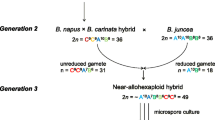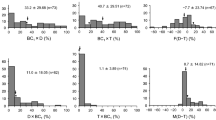Abstract
An F2 population (Allium fistulosum x A. cepa) of 20plants, 10 BC1,[(A. fistulosum x A. cepa) x A. cepa], and 50 BC2 plants, [(A. fistulosum x A. cepa) x A. cepa] x A. cepa were studied cytogenetically and characterized for four isozyme alleles plus various morphological characteristics. All of the progenies were in A. fistulosum (the bunching onion) cytoplasm. In the F2 population we observed non-random chromosomal and allelic segregation, suppression of bulb onion allelic expression, and abnormalities in mitosis and meiosis. Most BC2 plants resembled A. cepa (the bulbing onion) morphologically, but anthers, filaments, pistils, and petals were abnormal. Only 3 plants, and these were most nearly like the F1 hybrid morphologically, produced any seeds.The data and observations support the hypothesis of nuclear-cytoplasmic incompatibility interactions between the bunching and bulb onion species.
Similar content being viewed by others
References
Backer LC, Allen JW (1987) Meiotic origin of aneuploidy: an overview. In: Aneuploidy, part A: incidence and etiology. Alan R Liss, New York, pp 219–232
Bark OH, Havey MJ, Corgan JN (1994) Restriction fragment length polymorphism analysis of progeny from an Allium fistulosum by Allium cepa. Hybrid J Amer Soc Hortic Sci 119:1046–1049
Cryder CM (1988) A study of the associations of heritable traits in progeny from the interspecific backcross of (Allium fistulosum L. x Allium cepa L.) x A. cepa L. PhD thesis, New Mexico State University, Las Cruces, N.M.
Cryder CM, Corgan JN, Urquhart NS, Clason D (1991) Isozyme analysis of progeny derived from (Alliumfistulosum x Allium cepa)xAllium cepa. Theor Appl Genet 82:337–345
De Vries JN (1990) Onion chromosome nomenclature and homoeology relationships workshop report. Euphytica 49:1–3
Emsweller SL, Jones HA (1935a) An interspecific hybrid in Allium. Hilgardia. 9:265–273
Emsweller SL, Jones HA (1935b) Meiosis in Allium fistulosum, Allium cepa, and their hybrid. Hilgardia 9:277–288
Emsweller SL, Jones HA (1945) Further studies on the chiasmata of the Allium cepa x A. fistulosum hybrid and its derivatives. Am J Bot 32:370–379
Ford JH (1987) Chromosome displacement hypothesis. In: Aneuploidy, part A: incidence and etiology. Alan R Liss, New York, pp 237–247
Gates RR (1911) Pollen formation in Oenothera gigas. Ann Bot 25:909–974
Graves JAM (1988) Genome instability in interspecific cell hybrids I. Unstable expression of genes in divergent cell hybrids. J Genet 67:9–22
Jones RN, Rees H (1968) Nuclear DNA variations in Allium. Heredity 23:591–605
Kalkman ER (1984) Analysis of the C-banded karyotype of Allium cepa L. tandard system of nomenclature and polymorphism. Genetica 65:141–148
Levan A (1936) Die Zytologie von Allium cepa x A. fistulosum. Hereditas 21:195–214
Levan A (1941) The cytology of the species hybrid Allium cepa x A fistulosum and its polyploid derivatives. Hereditas 27:253–272
Maeda T (1937) Chiasma studies in Allium fistulosum, Allium cepa and their F1, F2, and backcross hybrids. Jpn J Genet 13:146–159
Mascarenhas JP (1990) Gene activity during pollen development. Annu Rev Plant Physiol Plant Mol Biol 41:317–338
McClintock B (1984) The significance of responses of the genome to challenge. Science 226:792–801
McCollum G (1974) Hybrid origin of top onion, Allium cepa, var ‘viviparum’. Z. Pflanzenzucht 71:222–232
Netzer D, Rabinowitch HD, Weintal CH (1985) Greenhouse technique to evaluate onion resistance to pink-root. Euphytica 34:385–391
Peffley EB (1986) Evidence for chromosomal differentiation of Allium fistulosum and A. cepa. J Am Soc Hortic Sci 111:126–129
Peffley EB, Currah L (1988) The chromosomal locations of enzymecoding genes in Adh-1 and Pgm-1 in Allium fistulosum. Theor Appl Genet 75:945–949
Peffley EB, Corgan JN, Horak HG, Tanksley SD (1985) Electrophoretic analysis of Allium alien addition lines. Theor Appl Genet 71:176–184
Sax K (1938) Chromosome aberrations induced by X-rays. Genetics 23:494–516
Schulz-Schaeffer J (1980) Cytogenetics, plants-animals-humans. Springer, Berlin Heidelberg New York
Smith L (1942) Cytogenetics of a factor for multiploid sporocytes in barley. Amer J Bot 29:451–456
Stadler LJ (1931) The experimental modification of heredity in crop plants I. Induced chromosome irregularities. Sci Agric 11:557–572
Ulloa-G M (1993) A cytogenetic, isozyme and morphological study on interspecific progenies from Allium fistulosum x Allium cepa crosses. Ph.D. Thesis, New Mexico State University, Las Cruces, NM
Ulloa-G M, Corgan JN, Dunford M (1994) Chromosome characteistics and behavior differences in Allium fistulosum L., A. cepa L., their F1 hybrid, and selected backcross progeny. Theor Appl Genet 89:567–571
Van der Meer QP, van Benekom JL (1978) Improving the onion crop (Allium cepa L.) by transfer of characters from Allium fistulosum L. Bull Warzywhiczy XXII, Instytut Warzywhictwa Skierniewice
Van der Valk P, de Vries SE, Everink JT, Verstappen F, de Vries JN (1991) Preand post-fertilization barriers to backcrossing the interspecific hybrid between Allium fistulosum L. and A. cepa L. with A. cepa. Euphytica 53:201–209
Vallejos CE, Tanksley SD (1983) Segregation of isozyme markers and cold tolerance in an interspecific backcross of tomato. Ther Appl Genet. 66:241–247
Vosa CG (1976) Heterochromatin patterns in Allium. I The relationship between the species of the cepa group and its allies. Heredity 36:383–392
Author information
Authors and Affiliations
Additional information
Communicated by D. R. Pring
Use of trade names does not imply endorsement of the products named nor criticism of similar ones not named. This research was supported by the New Mexico Agricultural Experiment Station.
Rights and permissions
About this article
Cite this article
Ulloa-G, M., Corgan, J.N. & Dunford, M. Evidence for nuclear-cytoplasmic incompatibility between Allium fistulosum and A. cepa . Theoret. Appl. Genetics 90, 746–754 (1995). https://doi.org/10.1007/BF00222143
Received:
Accepted:
Issue Date:
DOI: https://doi.org/10.1007/BF00222143




